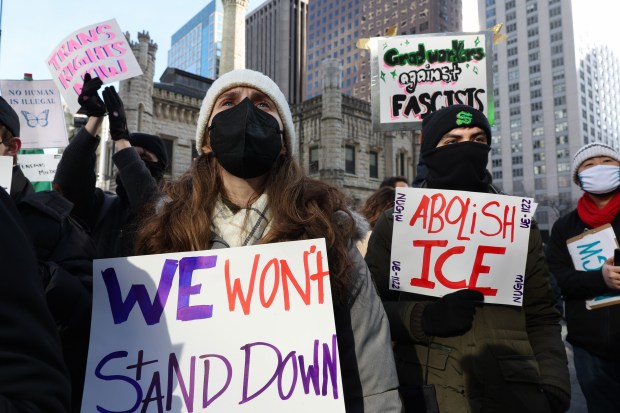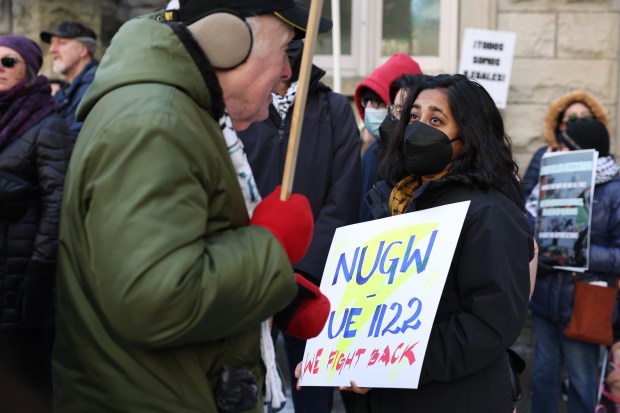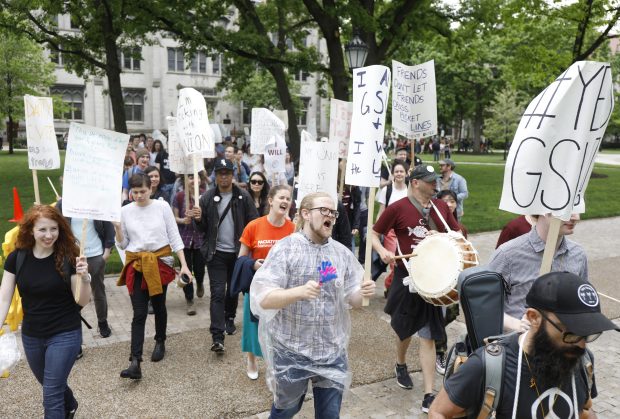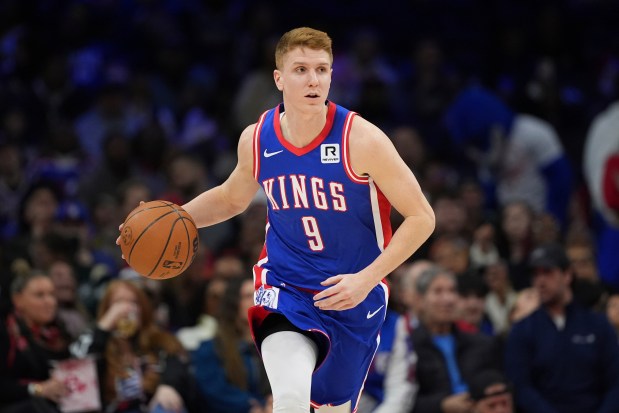Andy Archer did not know what was going to come first: a raise from a new union contract or the birth of his first child.
The third-year doctoral student had spent months bargaining with his employer — the University of Chicago — on everything from increasing pay for research and teaching assistants to expanding health care benefits. Archer had been involved in other organizing efforts before, but bargaining for his graduate student union he said was “one of the most thrilling projects” he’d ever been a part of.
But then, in March 2024, the union reached an agreement with the university. For Archer, that meant a stipend increase from about $33,000 in 2023 to $45,000 in 2024, with a 3% increase each year for the next two years, he said.
And the contract came just in time for Archer — right before ratification, his son was born.
“I finally felt like I was at a stable enough point in my life where I had enough job security and had a stable enough wage that I could have a kid and start a family,” he said. “It was night and day for sure.”
While the contract is new, the fight for better benefits and recognition has been a long time coming for the University of Chicago union, which began nearly two decades ago. Their gains include salary increases, guaranteed union representation during Title IX processes, prohibiting the university from releasing immigration status of union members to the Department of Homeland Security unless legally required to do so and notifying the relevant party whenever possible if their information is released to DHS.
But now, the administration of President Donald Trump could threaten some of the progress graduate student unions have made not only at UChicago, but at private universities across the country. In his first term, Trump’s administration sought to restrict graduate students’ abilities to be recognized as employees. That previous policy, combined with other legislation surrounding immigration and gender discrimination, poses a threat for unions.
With this in mind, graduate student unions are gearing up for the second Trump administration — and feel more confident than ever in their ability to fight back. That looks like everything from educating members on their rights to showing up to local protests and, if necessary, holding protests of their own. New protections won under some contracts also provide an extra layer of protection for graduate students against threats of deportation by the Trump administration, among other issues.
Since 2012, graduate student employee union representation has seen an increase of 133% nationwide according to a report by the National Center for the Study of Collective Bargaining in Higher Education and the Professions. Much of that uptick took place under the National Labor Relations Board with the administration of President Joe Biden that generally skewed pro-union.
With the first Trump NLRB taking a more anti-union approach, experts are anticipating the next administration to be similarly anti-union, but this time around, more graduate student unions are better prepared to handle whatever is thrown their way.
“People on the ground realize ‘We’ve dealt with this before … We know how to navigate this,’” said Gary Rhoades, a professor of higher education at the University of Arizona. “There are far more graduate student unions today than there were eight years ago and those unions themselves have gotten stronger.”
Whether graduate students can be considered employees — and therefore form unions — has plagued universities and lawmakers for decades. While the status of graduate union formation at public universities is left up to individual states, graduate unions at private universities are a matter for the NLRB.
How the NLRB rules on this issue can change with whoever is in power. Under President George W. Bush, the NLRB ruled in 2004 that graduate students at Brown University do not have the ability to unionize. That all changed in 2016, when the NLRB under President Barack Obama reversed that 2004 decision in a case with Columbia University.
Despite the 2016 decision, many graduate student unions like UChicago and Northwestern University paused their petitioning efforts under the first Trump administration, for fear that their petition could allow the first Trump NLRB to overturn the Columbia ruling. That same NLRB also sought to restrict graduate student unionization activities in 2019 with a proposed rule that said that graduate students who earned wages from their university were not employees. The proposal was eventually withdrawn under the Biden-appointed NLRB.
UIC undergraduate resident advisers move to unionize: ‘These are workers’
Once the pandemic passed and graduate students were confident in their ability to unionize, many started petitioning the Biden-era NLRB for official recognition. In the past two years, the NLRB has certified over 50 new bargaining units for undergraduate and graduate student employees, with more than half of those bargaining units representing graduate students. Over 53,000 student employees are represented by unions at private universities, according to former NLRB spokesperson Kayla Blado.
Since taking office, Trump has taken steps to overhaul the NLRB. He fired Jennifer Abruzzo, the general counsel of the NLRB, on Jan. 27, similar to what Biden did during his term. The general counsel’s responsibilities include the authority to have the NLRB reexamine issues and make determinations about legal issues in relation to the National Labor Relations Act. Abruzzo was broadly viewed as taking a more active approach in enforcing private sector workers’ rights to unionize during her tenure.
Trump also fired board member and former NLRB Chair Gwynne Wilcox, whose term was supposed to last until August 2028. This leaves Trump with three open NLRB slots to fill, and with a Republican-majority Senate, his picks are likely to get confirmed. So far, Trump has appointed current NLRB member Republican Marvin Kaplan as chair of the board. It is unclear when he will fill the other open slots.
“There is a likelihood that a new majority of appointees by President Trump … may be inclined to revisit the Columbia University decision, and either reverse it in total or modify it substantially,” said William Herbert, executive director of the National Center for the Study of Collective Bargaining in Higher Education and the Professions.

Wilcox described the move to fire her as “unprecedented and illegal,” writing in a statement that she will pursue legal avenues to challenge her removal. The move to fire her also means that the NLRB does not have enough members to hold a quorum, halting the NLRB from carrying out certain duties such as adjudicating routine cases.
“The firing of NLRB board member Gwynne Wilcox violates an explicit provision of federal labor law and reflects a disregard for the rule of law,” Herbert said. “It is a very ominous sign concerning labor law protections for graduate student employees and others who work for private employers.”
With a new administration in mind, petitioning the board for new unions is likely to slow under the next Trump administration.
“I think unions are going to tread lightly in the next four years,” said Damien DiGiovanni, a lawyer who worked on unionization cases at schools like Harvard, MIT and Tufts, emphasizing that no school wants to accidentally overturn the Columbia decision. Some student unions, such as at Vanderbilt University, withdrew their petitions before Trump even took office.
University of Chicago grad students vote overwhelmingly to unionize
Institutions could also leverage the new NLRB to help overturn the Columbia decision, according to Rhoades. He pointed to a case with nontenure track faculty at the University of Southern California where the university argued that those faculty members were not only ineligible to unionize, but also that the NLRB as a whole was “unconstitutional.”
“This is an example of an institution saying, ‘OK, we got a new administration coming in. Maybe they’ll be receptive to this argument that the NLRB itself is unconstitutional,’” Rhoades said. “So I think just as during the first Trump administration, there will be universities that leverage the policies of the (second) Trump administration to their management’s believed benefit by resisting unionization.”
At the same time, Rhoades also recognized that even if graduate student unions lose their formal recognition, there is a possibility that some institutions will voluntarily recognize these unions and continue to bargain with them.
While the petitions may slow, the fight in higher education is likely to keep going — both to keep their labor rights and to protect students of other marginalized backgrounds.
Northwestern graduate student workers vote to unionize after years of organizing
Summer Pappachen, a fourth-year doctoral student in political science at Northwestern, said she felt “energized” to fight after hearing Trump won again. His win even motivated her to step up into her leadership role as vice president of the Northwestern grad union.
“As a union leader right now, you’re not really allowed to have any other feeling other than being ready to fight and stand up and organize harder than ever,” Pappachen said.
What that action will look like will depend on the policies of the next administration, but the Northwestern graduate student union is already preparing themselves by attending symposiums on immigrant rights in Chicago.
“The first step is definitely educating stewards … and members on rights and also on the risks that this administration poses,” Pappachen said.
The most recent contract the Northwestern union won also prohibits the university from disclosing immigration status to the Department of Homeland Security unless legally compelled to do so, similar to those of UChicago.
“That was one of our biggest wins for international workers,” said Mounica Sreesai, an international doctoral student and president of the Northwestern University union, emphasizing the importance of having that additional layer of protection in the contract.

And if the university does not follow that part of the contract — or any part of the contract — Pappachen and Sreesai both said the union is not afraid to organize a protest. Sreesai and Pappachen also both said that the union attended a march on Jan. 25 pushing back against the Trump administration’s immigration policies.
But above all, union representatives and experts the Tribune spoke with emphasized that the most important part was having union members who are willing to fight for and protect their rights.
“I think that our union is in the strongest position we’ve ever been and we are ready to face what comes,” Archer said, emphasizing the popular support for the union by its members. “Our power has always come from our member-level organizing, not necessarily from the rights that we get from the NLRB.”
Sreesai echoed a similar sentiment.
“It’s important for me and my rights,” she said. “My strength comes from collectivity and a union is my front.”




